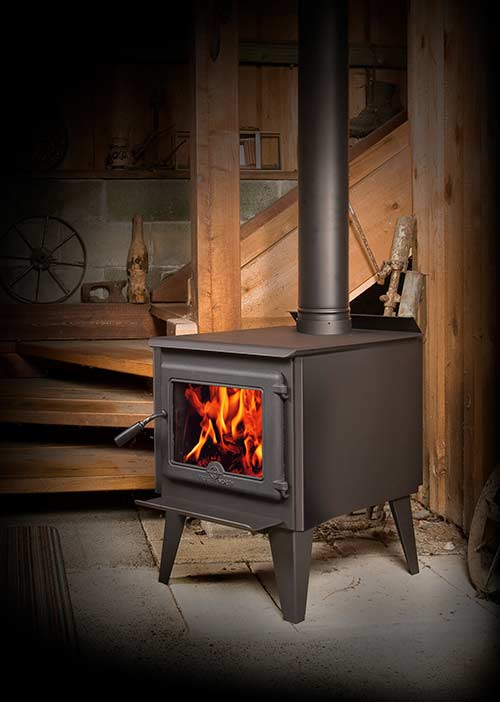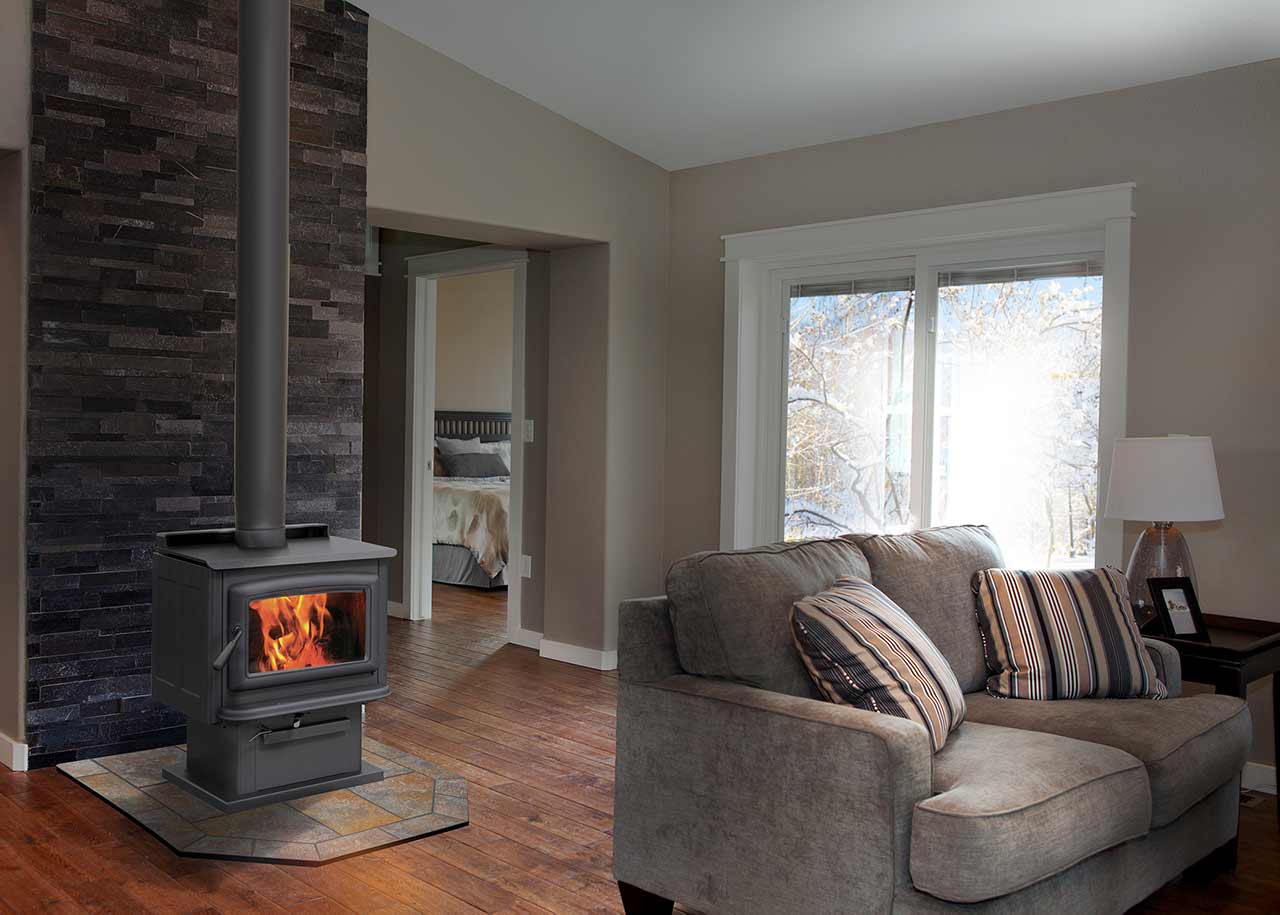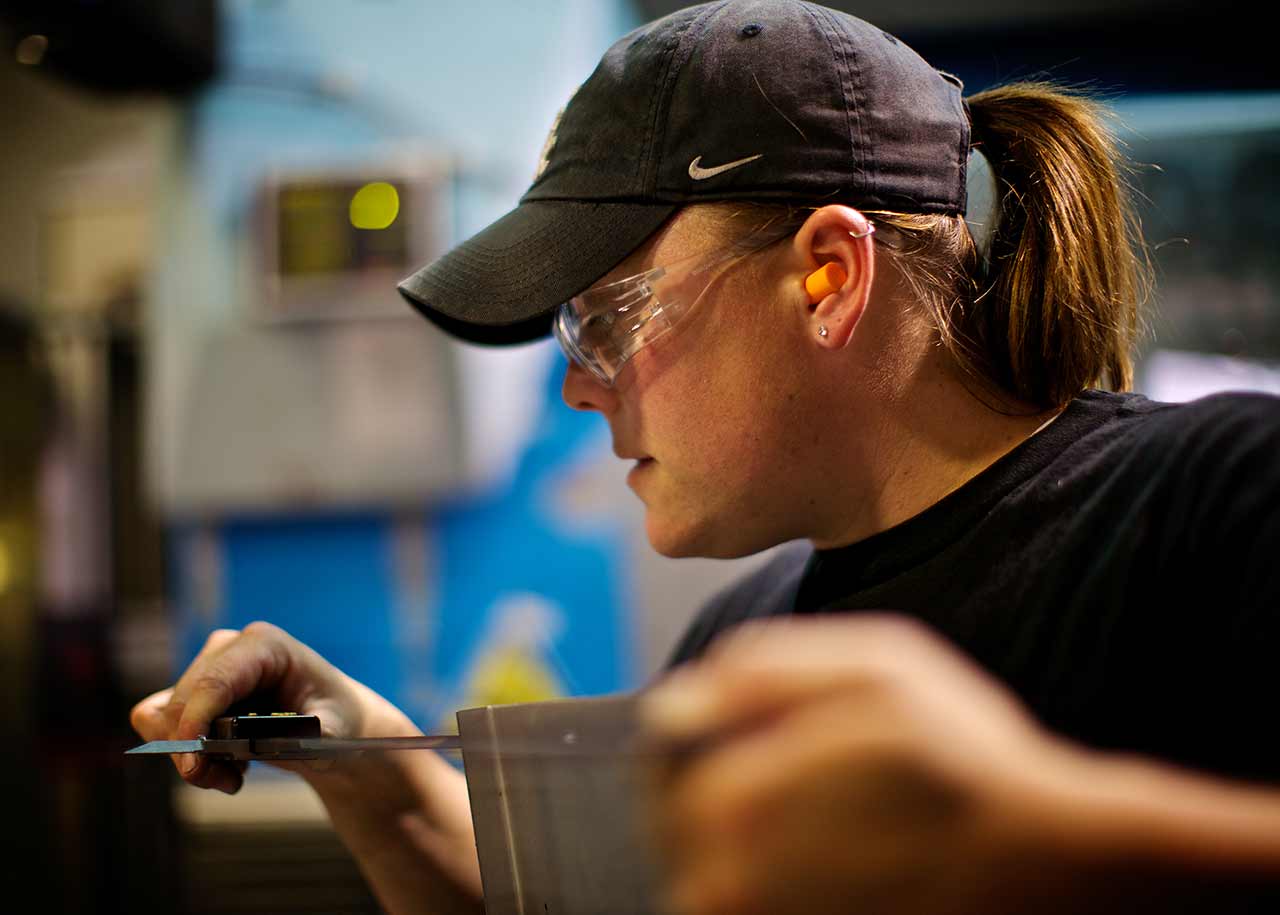
Pacific Energy’s catalytic-free wood stoves test under the 2-gram standard required by the EPA in 2020. [Photo: Courtesy of Pacific Energy]
Pacific Energy is pushing the industry forward with innovative, environmentally friendly solutions.
Imagine a cozy fireplace warming a family on a cold night, smoke billowing up the chimney and out into the winter sky. Today we know what’s wrong with this scene. The smoke from burning wood can be harmful, the fine particulates contribute to pollution levels and raise health concerns. But that doesn’t mean a wood fireplace is a bad choice for your home. Wood is a completely renewable energy and, with access to fairly priced firewood, one of the cheapest ways to heat a house. Modern wood burning fireplaces and stoves have evolved well past their heavy polluting predecessors. “With a modern wood stove and dry wood, you don’t see smoke. That’s the bottom line,” says Cory Iversen, sales manager for Pacific Energy.
It wasn’t long ago that this was far from the case. In the 1970s, when the EPA was founded, a wood stove emitted around 60 to 70 grams of particulate per hour. By 2020 the EPA is enforcing a two-gram particulate emission standard. The current standard is four-and-a-half grams, and the industry’s scramble to cut emissions in half has begun.
Fortunately, Pacific Energy is ahead of the game. They set their sights on the goal two years ago, when the 2020 standard was still talk. Today their products are already testing under the 2-gram standard, and they’ve managed to do it the hard way—without catalytic technology. A catalyst device is often added to wood burning systems to lower emissions by burning the particulates at a higher temperature through a chemical reaction before they disperse. Iversen argues that a catalytic system is a fast fix but isn’t the best solution for long-term performance. “A lot of the products currently out there are going to be turned into catalytic because that is by far the easiest way to get it to pass the new standard. Not the best way, but it is the easiest way,” he says.
Pacific Energy has focused its energy and resources into developing catalytic-free technology because they believe it’s the best choice for consumers and the environment. Their innovation and quality of products resonates as a company that refuses to settle.
FROM OUR MAY+JUNE 2019 ISSUE

The preferred publication of leading green professionals.

The True North line offers entry-level products that meet the 2020 regulations at even more accessible prices. [Photo: Courtesy of Pacific Energy]
Are Catalytic Combustors a Short-Term Solution?
“There’s really nothing wrong with the theory,” Iversen says regarding catalytic technology. “Where the challenge comes in is usability.”
The catalyst itself is a ceramic and honeycomb shaped plate coated with metal. With the plate heated to a high temperature, smoke and ash passes through its pores, where they are ignited and burned off, creating more heat while less particles escape to the outside. Not only is the concept simple, it can be added to already existing products—making it especially attractive to manufacturers keeping up with developing emission regulations.
In practice, a catalytic stove works less effectively than it does in the test lab. Wood is considered a highly variable fuel; its quality, the moisture content, and even its species, all play a part in how it burns. Users might even throw in treated wood, coal, or colored and glossy paper as fire starters. All of these things reduce the effectiveness of a catalyst and might lead to necessary maintenance or replacement of the piece entirely. The catalyst also requires a bypass, while starting or re-loading the appliance you must bypass the catalytic, this not only creates usability issues for the customer but if not used properly or left open can severely impact the efficiency and emissions of the appliance.
Even when a catalytic stove is operated correctly, the catalyst will degrade over time. Iversen says there’s a lot of misinformation on how fast that can happen. While some manufacturers might state a 10-year warranty on their catalytic, suppliers and manufacturers advertise a catalyst is only effective for two to five years without user error. “There’s really no way for the consumer to tell,” he says. “How many end up being used when they aren’t working properly?”
Pacific Energy has cut out manufacturing with catalysts entirely. Iversen says their team investigated the issue many times as technology changed, and they’ve never been convinced it’s the right direction. Their catalytic-free stoves use secondary burn systems—the injection of clean preheated air into the unburned particulate of the fire. Like a catalytic version, the particulates are reignited and burned again before they escape. While many agree catalytic-free stoves are more durable and user-friendly, historically catalytics tested cleaner in a laboratory setting. Today that is no longer true.

Pacific Energy’s stoves are durable, user-friendly, and clean. [Photo: Courtesy of Pacific Energy]
How Will the 2020 Standard Affect the Industry?
Pacific Energy knows getting down to a 2-gram particulate regulation isn’t easy. It’s even harder to do without a catalyst. Existing testing labs will feel the strain of an entire industry upgrading their products at once. It’s likely that a significant amount of products in the industry will be taken off the market. In other words, their sales either won’t warrant retesting, or the product simply won’t be able to meet the new standard. Of the products left, many will evolve into catalytic systems. Despite controversy on reliability, durability, and usability, a catalyst is still the simplest way to upgrade a product to meet emission standards. But Iversen cautions that a better testing stove doesn’t always translate into a better performing stove in the real world. “It’s going to be a real change in the industry,” he says. “You don’t necessarily have a better selection of high-performance products. You just have products that manage to pass a test.”
The desire to regulate emission standards is understandable, though some argue a greater focus should be placed on discarding the old stoves already in existence. Some states have already implemented change-out programs where removing an old stove results in a credit toward a new one. “You have one whole stove that’s not highly engineered, and it will wipe out the gains of the next 20,” says Iversen.

[Photo: Courtesy of Pacific Energy]
How Does Non-Catalytic Work?
A non-catalytic stove uses perforated steel tubes or a perforated baffle across the top of the firebox to introduce air across the top of the stove. The air mixes with the rising gases; maximizing the combustion. Traditionally Pacific Energy products use a hollow baffle system—a unique choice. Though many agree the baffle is more reliable and can be more useful for medium to high burns, tubes tend to be easier for testing and cheaper to manufacture. Baffle systems also come at a higher price and manufacturers often steer away from the expense. For this reason, Pacific launched its True North line—stoves and inserts that utilize the tube system to offer a lower cost entry-level product. The line offers catalytic-free systems that meet 2020 regulations at even more accessible prices.

[Photo: Courtesy of Pacific Energy]
Changing the Industry
Non-catalytic technology isn’t exclusive to Pacific Energy, but you’d be hard-pressed to find a manufacturer that has done more to drive its development. Over the course of 40 years, the company’s endless innovation has resulted in a new standard for secondary burn systems.
Also unique to Pacific Energy products is their floating firebox system. In most stoves, a firebox is vulnerable to premature fatigue or failure. The floating design allows parts to expand and contract without wearing on the metal. Overall, the system can add years to a stove’s life. During that time, users will enjoy a creosote-free viewing window, too. Pacific Energy was the first to effectively use an air wash manifold system, where combustion air flows across the glass’s surface to keep it clean. Pacific Energy has continuously refined the airwash design and offers up some of the cleanest viewing glass in the industry.
Today, Pacific Energy continues to develop new ways to heat with wood, and with a long history of innovation, they are confident they can keep developing products that customers can enjoy, are easy to operate, and meet the latest EPA regulations.
